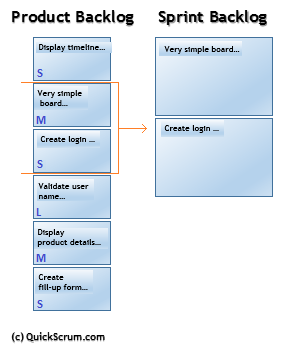In many ways, in a Scrum project, the sprint planning meeting agenda plays a very
significant part in determining the success of delivering shippable product
increments through the sprint iterative cycles. The product owner is very
closely involved in the sprint planning agenda, and is responsible for the
outcome of the sprint cycle, since he or she is primarily responsible for
taking the initiative and “designing” the sprint – the PO decides which user
stories should be ideally taken up for development purposes based upon their
business values. Moreover, the product backlog needs to be refined on a regular
basis. The PO may invite and seek the help of Agile team members to keep the
backlog refined so “granular” and developable user stories are available at the
time of Scrum planning meeting.
The main issue with Agile Scrum today is that the role of a PO
cannot be “standardised” based upon assumptions as to how Scrum ought to be
implemented in a project, and what the PO should ideally do to make the project
a distinct success. In addition, while considering Scrum sprint planning, the
same thoughts might be applicable to it as those associated with the PO’s – it
is difficult to create generalised rules regarding how a sprint should be
ideally designed. The primary reason is products and requirements change as per
fluctuating market conditions, and stakeholders too are liable to change their
thoughts as and when end user demand user-specific requirements and
development. However, after considering the fact that scaled Scrum versions are
likely to “dominate” the Agile scenario over the coming years, it is worthwhile
thinking that “some” of the duties of a PO and certain sprint planning
“characteristics” are likely to remain common – irrespective of which scaled
version is used, and the manner in which Scrum should be, or can be, implemented
in a project. In addition, while the sprint planning meeting was traditionally
conducted in two parts, the Scrum event has now evolved to be conducted as a
whole – as a single event – and include two topics in it, rather than two
parts:
- What
can be done in this (currently being planned) sprint – the “What” aspect
- How
should the chosen “work” be ideally “done” – the “How” aspect
It is interesting to think about how the product owner’s role is likely to modify itself in the future, and what features the sprint planning
event is likely to include. The suggestions are open for debate, and the reader
is invited to present his or her viewpoints.
Scrum product
owner role and responsibilities likely to remain “common”
- Creation of the product backlog based upon the
vision as seen by the stakeholders. Defining user stories having high
business values so the project “worth” is maintained at all times.
- Monitoring all Scrum related activities in project. Even if the PO’s role may be demanding and “difficult to play”, the PO still has to deal with changing market conditions, stakeholders requests, and negotiate with the development team with regards delivering shippable stories and maintaining team velocity... Read more at Scrum Product Owner Role And Sprint Planning Meeting Agenda
